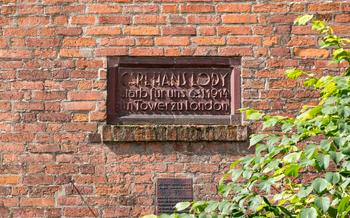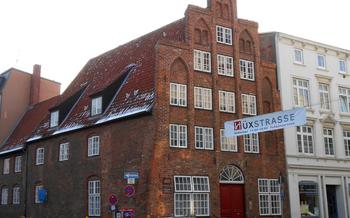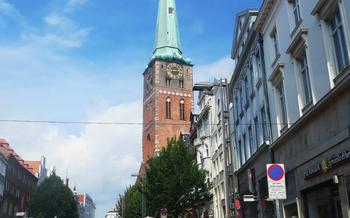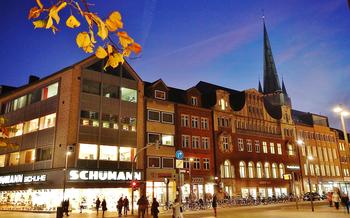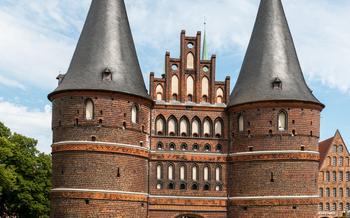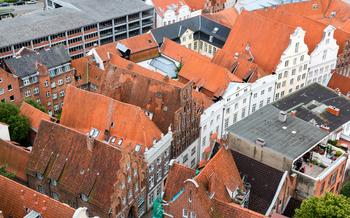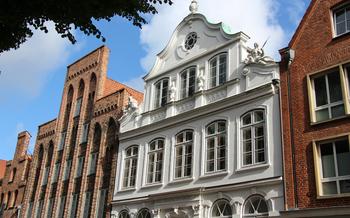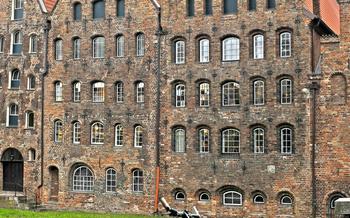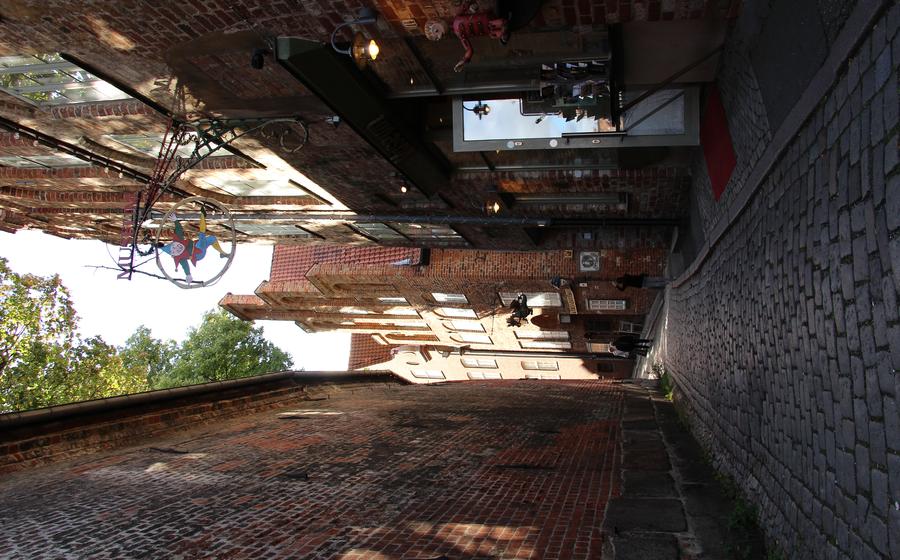
Kreuzweg Stationen
- Lübeck's Kreuzweg Stationen: A Path of Faith and Reflection
- Location and Access: Finding the Kreuzweg Stationen
- Historical Context: The Kreuzweg Stationen Through the Ages
- Pilgrimage and Spirituality: A Journey of Faith
- The Stations: Symbolism and Meaning
- Architectural Highlights: A Journey Through Art and History
- Hidden Gems: Discovering Lesser-Known Stations
- Practical Tips for Visitors: Planning Your Pilgrimage
- Best Time to Visit
- Dress Code
- Guided Tours
- Accessibility
- Accommodation and Dining: Where to Stay and Eat in Lübeck
- Souvenirs and Mementos: Taking a Piece of Lübeck Home
- Events and Festivals: Experiencing Lübeck's Cultural Side
- Beyond the Kreuzweg: Exploring Lübeck's Other Treasures
- Family-Friendly Activities: Lübeck for All Ages
- Photo Opportunities: Capturing the Essence of Lübeck
- Insider Tip: Discovering Lübeck's Hidden Courtyard
Lübeck's Kreuzweg Stationen: A Path of Faith and Reflection
The Kreuzweg Stationen, or Stations of the Cross, in Lübeck, Germany, is a significant pilgrimage site that holds immense historical, architectural, and religious importance. The Kreuzweg consists of 14 stations depicting the journey of Jesus from his condemnation to his crucifixion and resurrection. Each station features intricate artwork and symbols that capture the essence of Jesus' suffering and sacrifice.
The Kreuzweg was established in the 15th century and has since become an integral part of Lübeck's religious landscape. It serves as a place of reflection and meditation for Christians, who come from far and wide to walk the path and contemplate the events leading up to Jesus' crucifixion. The Kreuzweg is not only a symbol of faith but also a testament to the city's rich cultural heritage and enduring traditions.
Location and Access: Finding the Kreuzweg Stationen
The Stations of the Cross, located in the historic city of Lübeck, Germany, offer a unique and spiritually enriching experience for visitors. Getting to the Kreuzweg Stationen is a breeze, with various transportation options available.
Transportation and Directions:
-
By Foot: The Kreuzweg Stationen is conveniently situated within walking distance from Lübeck's city center. From the main train station, Lübeck Hauptbahnhof, it's a leisurely stroll along cobbled streets for approximately 15-20 minutes.
-
By Bus: Public transportation is another excellent option. Take bus number 6 or 10 from the central bus station, ZOB Lübeck, and get off at the stop "Am Stau" or "St. Lorenz Kirche." From there, it's just a short walk to the Kreuzweg Stationen.
-
By Car: If you're driving, follow the signs to the city center and look for the parking garage "Parkhaus am Dom" or "Parkhaus Altstadt." These garages offer convenient parking options near the Kreuzweg Stationen.
Starting Point:
The journey begins at the first station, which is situated opposite the St. Lorenz Church. Look for a prominent stone cross that marks the starting point of the Kreuzweg.
Duration:
Plan approximately 1-2 hours to complete the walk, including stops at each station for reflection and prayer. The duration can vary depending on your pace and the time you spend at each station.
Accessibility:
The Kreuzweg Stationen is generally accessible for visitors with disabilities or limited mobility. However, some sections of the path may have uneven surfaces or steps. If you have concerns, please contact the local tourism office or a tour operator for assistance.
Historical Context: The Kreuzweg Stationen Through the Ages
The Kreuzweg Stationen in Lübeck holds significant historical and cultural importance. Its origins can be traced back to the 15th century when the city was a prominent center of Christianity. The stations were initially erected as a means of providing a visual representation of the Passion of Christ, allowing pilgrims and residents to follow the journey of Jesus from his condemnation to his crucifixion.
Over the centuries, the Kreuzweg Stationen has undergone various changes and renovations. In the 17th century, the stations were rebuilt in a Gothic style, reflecting the architectural trends of the time. During the 19th century, the stations were restored and embellished with intricate sculptures and artwork, further enhancing their artistic and religious significance.
Despite the passage of time and the changing religious landscape, the Kreuzweg Stationen has retained its spiritual importance for Christians in Lübeck. It continues to serve as a place of pilgrimage, reflection, and prayer, attracting visitors from near and far who seek a deeper connection with their faith. The Kreuzweg Stationen stands as a testament to Lübeck's rich history, its enduring religious traditions, and its commitment to preserving its cultural heritage.
Pilgrimage and Spirituality: A Journey of Faith
The Kreuzweg Stationen holds immense religious significance for Christian pilgrims, serving as a powerful symbol of faith and spirituality. It forms part of a larger network of pilgrimage routes across Europe, attracting devout believers seeking a deeper connection with their faith.
As pilgrims traverse the path, they engage in prayer, meditation, and contemplation at each station, reflecting on the suffering and sacrifice of Jesus Christ. The stations serve as a reminder of the challenges and trials faced by Jesus during his final journey, fostering a sense of empathy and compassion among pilgrims.
Personal experiences of pilgrims who have walked the Kreuzweg reveal the profound impact it has on their spiritual journey. Many describe a sense of peace, tranquility, and renewed faith as they immerse themselves in the Stations of the Cross. The Kreuzweg provides a unique opportunity for pilgrims to deepen their understanding of the Christian faith and strengthen their connection with God.
The Stations: Symbolism and Meaning
The Kreuzweg Stationen is not just a historical monument but also a journey of faith and reflection. Each station along the path holds unique artistic depictions, biblical references, and emotional significance. The artwork at each station brings to life the events of Jesus's crucifixion, evoking feelings of empathy, sorrow, and hope.
The stations feature intricate carvings, sculptures, and reliefs that depict scenes from the Bible, such as Jesus carrying the cross, meeting his mother Mary, and being crucified. These artistic representations help visitors to visualize and connect with the events of Jesus's journey.
The biblical references associated with each station enhance the spiritual experience. Visitors can reflect on the specific passages from the Bible that correspond to each station, deepening their understanding of the significance of Jesus's sacrifice.
The Kreuzweg Stationen is designed to evoke a range of emotions in visitors. The Stations of the Cross are a powerful reminder of Jesus's suffering and sacrifice, inviting visitors to contemplate the depth of his love and compassion. The stations also offer hope and redemption, symbolized by the resurrection of Jesus at the final station.
Visitors are encouraged to take their time at each station, to reflect on the symbolism and meaning, and to pray or meditate. The Kreuzweg Stationen provides a unique opportunity for visitors to connect with their faith and to gain a deeper understanding of the significance of Jesus's crucifixion and resurrection.
Architectural Highlights: A Journey Through Art and History
The Kreuzweg Stationen is not only a spiritual journey but also a journey through art and history. The stations are adorned with intricate carvings, sculptures, and reliefs that depict scenes from the Passion of Christ. These works of art are a testament to the skill and devotion of the craftsmen who created them.
The Kreuzweg Stationen is built in the Gothic style, which is characterized by its pointed arches, ribbed vaults, and flying buttresses. This architectural style is often associated with cathedrals and other religious buildings, and it creates a sense of awe and reverence.
One of the most striking features of the Kreuzweg Stationen are the sculptures that adorn each station. These sculptures depict scenes from the Passion of Christ, and they are carved with great detail and emotion. The figures are life-size, and they seem to come to life as you walk past them.
In addition to the sculptures, the Kreuzweg Stationen also features a number of reliefs. These reliefs are carved into the stone walls of the stations, and they depict scenes from the Bible. The reliefs are smaller than the sculptures, but they are equally detailed and expressive.
The Kreuzweg Stationen has been restored and preserved over the centuries, and it remains a testament to the skill and devotion of the people who created it. The stations are a beautiful and moving reminder of the Passion of Christ, and they are a must-see for anyone visiting Lübeck.
Hidden Gems: Discovering Lesser-Known Stations
While the Kreuzweg Stationen in Lübeck is a popular pilgrimage route, there are several lesser-known stations that offer unique features and historical significance. These hidden gems are often overlooked by visitors, but they are worth seeking out for a more intimate and reflective experience.
One such hidden gem is the Station of the Veronica's Veil, located in a quiet corner of the city. This station features a beautiful carving of Veronica wiping the face of Jesus with her veil, capturing a moment of compassion and tenderness. The intricate details of the carving and the serene atmosphere of the station make it a particularly moving experience.
Another hidden gem is the Station of the Agony in the Garden, situated in a small park. This station depicts Jesus praying in the garden of Gethsemane, surrounded by sleeping disciples. The peaceful setting of the park and the poignant depiction of Jesus' struggle create a contemplative atmosphere that invites visitors to reflect on the humanity of Christ.
These are just a few examples of the hidden gems that can be found along the Kreuzweg Stationen in Lübeck. By venturing off the beaten path, visitors can discover unique stations that offer a deeper understanding of the Stations of the Cross and a more personal connection to the pilgrimage experience.
Practical Tips for Visitors: Planning Your Pilgrimage
Embarking on a pilgrimage to the Kreuzweg Stationen requires careful planning to ensure a meaningful and fulfilling experience.
Best Time to Visit
- Aim for spring (April-May) or autumn (September-October) for pleasant weather.
- Avoid peak summer crowds (July-August) for a more serene atmosphere.
- Choose a weekday over a weekend for fewer visitors.
Dress Code
- Respect the religious nature of the site by dressing modestly.
- Opt for comfortable clothing and footwear suitable for walking.
Guided Tours
- Consider joining a guided tour for insights into the history and significance of the Kreuzweg.
- Tours are typically offered in German, but English tours may be available upon request.
Accessibility
- The Kreuzweg is mostly accessible to visitors with disabilities or limited mobility.
- Some stations may have steps or uneven surfaces, so it's advisable to plan accordingly.
- Wheelchairs can be rented from the Lübeck Tourist Information Center.
Accommodation and Dining: Where to Stay and Eat in Lübeck
Lübeck offers a range of accommodation options to suit different budgets and preferences. For a truly immersive experience, consider staying in a traditional Hanseatic-style hotel or guesthouse located in the heart of the city's historic district. These charming accommodations often feature period furnishings and décor, transporting guests back in time.
When it comes to dining, Lübeck is a culinary paradise, offering a diverse range of restaurants catering to all tastes. Indulge in traditional German cuisine at one of the many cozy restaurants in the city center, where you can savor hearty dishes such as schnitzel, bratwurst, and sauerkraut. For a taste of local specialties, try the famous Lübeck marzipan, a sweet treat made from almonds and sugar that has been a local delicacy for centuries.
Lübeck is also home to a vibrant cafe and bakery scene. Start your day with a freshly brewed coffee and a flaky pastry at a traditional German bakery, or enjoy a leisurely afternoon tea in one of the city's charming cafes. For those seeking a quick bite, there are numerous street food stalls and food trucks offering a variety of local and international cuisine.
To experience the true essence of Lübeck's culinary delights, visit one of the city's many local markets. Here you can browse stalls selling fresh produce, artisanal cheeses, and homemade delicacies. The markets are also a great place to pick up souvenirs and gifts, such as locally produced honey, jams, and crafts.
Souvenirs and Mementos: Taking a Piece of Lübeck Home
As you embark on your pilgrimage through the Kreuzweg Stationen, you may want to take home a memento of your journey. The city of Lübeck offers a variety of religious items and local crafts that serve as beautiful reminders of your spiritual experience.
For those seeking religious mementos, there are shops near the Kreuzweg where you can purchase rosaries, crucifixes, prayer books, and other devotional items. These shops also sell candles, incense, and holy water, allowing you to recreate the spiritual atmosphere of the Kreuzweg in your own home.
Lübeck is also home to a thriving community of artisans and craftspeople who create unique and locally inspired souvenirs. From hand-painted ceramics to intricate wood carvings, you're sure to find a one-of-a-kind piece to treasure. Visit local markets or specialty shops to discover these hidden gems, and support the local economy while taking home a piece of Lübeck's charm.
Don't forget to indulge in Lübeck's culinary delights. The city is famous for its marzipan, a sweet almond paste that is crafted into various shapes and flavors. You can purchase marzipan candies, cakes, and other treats to enjoy at home or share with loved ones.
Finally, consider obtaining a pilgrimage certificate as a tangible reminder of your journey. These certificates are typically issued by churches or religious organizations and can be personalized with your name and the date of your pilgrimage. They serve as a symbol of your spiritual growth and the blessings you received along the way.
Events and Festivals: Experiencing Lübeck's Cultural Side
Lübeck offers a vibrant cultural scene, with various events and festivals taking place throughout the year. Immerse yourself in the city's rich heritage and traditions by attending one of these special occasions:
-
Lübeck Christmas Market: Experience the magic of the festive season at Lübeck's charming Christmas market, one of the oldest and most renowned in Germany. Browse handcrafted ornaments, indulge in traditional treats like mulled wine and gingerbread, and soak up the enchanting atmosphere.
-
Lübeck Music Festival: Music lovers will delight in the Lübeck Music Festival, a prestigious classical music event held annually in summer. Enjoy performances by renowned orchestras and soloists in the city's historic venues, including churches and concert halls.
-
Baltic Sea Philharmonic: Based in Lübeck, the Baltic Sea Philharmonic is a renowned orchestra known for its innovative and diverse repertoire. Catch a performance at their concert hall and be captivated by their musical virtuosity.
-
Lübeck Museum Night: Discover Lübeck's cultural treasures after dark during the annual Museum Night. Museums, galleries, and historical sites stay open late, offering free or discounted admission, special exhibitions, and unique events.
-
Hanseatic Days: Step back in time and witness the grandeur of Lübeck's maritime past at the Hanseatic Days festival. This lively event features parades, historical reenactments, traditional crafts demonstrations, and medieval feasts, transporting you to the city's glorious Hanseatic era.
Beyond the Kreuzweg: Exploring Lübeck's Other Treasures
While the Kreuzweg Stationen is a must-see attraction in Lübeck, the city offers a wealth of other treasures that are waiting to be discovered. History buffs will be enthralled by the Holstentor, a 15th-century city gate that is one of Lübeck's most iconic landmarks. The Marienkirche, a stunning Gothic church, is another must-see attraction, with its towering spires and intricate stained glass windows.
For those interested in art and culture, Lübeck has several museums that are worth a visit. The St. Annen Museum showcases a collection of medieval art and artifacts, while the Museum für Kunst und Kulturgeschichte Lübeck houses a diverse collection of art from the Middle Ages to the present day. The Günter Grass-Haus is a must-see for fans of the Nobel Prize-winning author, offering insights into his life and work.
Lübeck is also a great city for shopping. The Breite Straße, the city's main shopping street, is lined with boutiques, department stores, and specialty shops. Visitors can find everything from traditional German souvenirs to high-end fashion.
If you have time, consider taking a day trip to one of the many charming towns and attractions in the surrounding area. The seaside resort of Travemünde is a popular choice, with its long sandy beach and lively atmosphere. The medieval town of Ratzeburg, with its beautiful cathedral and lakefront setting, is another great option.
Family-Friendly Activities: Lübeck for All Ages
Lübeck is not just a city of historical significance and architectural wonders; it also offers a wealth of family-friendly activities that cater to visitors of all ages. From interactive museums to outdoor adventures and family-friendly restaurants, Lübeck has something to keep everyone entertained.
One of the highlights for families is the European Hansemuseum. This interactive museum brings history to life with hands-on exhibits, multimedia displays, and guided tours that make learning about the Hanseatic League fun and engaging for kids. Children can dress up in medieval costumes, participate in interactive games, and even try their hand at trading like a merchant.
For those seeking outdoor adventures, Lübeck offers several parks and green spaces perfect for picnics, playtime, and exploring nature. The Stadtpark Lübeck is a sprawling park with a playground, a petting zoo, and a miniature railway that kids will love. The Wakenitz River offers opportunities for boat trips, kayaking, and fishing, providing a fun and refreshing way to spend a summer day.
When it comes to dining, Lübeck has a range of family-friendly restaurants that cater to different tastes and budgets. From traditional German cuisine to international flavors, there are options to satisfy everyone in the family. Many restaurants offer special menus for children, high chairs, and changing facilities, making dining out with little ones a breeze.
Lübeck's family-friendly attractions and activities ensure that every member of the family has a memorable and enjoyable experience. Whether you're looking for interactive learning, outdoor adventures, or delicious dining options, Lübeck has something to offer families of all ages.
Photo Opportunities: Capturing the Essence of Lübeck
Lübeck is a visual delight, inviting photographers of all levels to capture its beauty. The Kreuzweg Stationen offer a unique opportunity to photograph religious art and architecture against the backdrop of the city's historic streets. Take advantage of the natural light during the golden hours of sunrise and sunset to create stunning images with warm hues and dramatic shadows. Don't miss the intricate details of each station, from the sculptures to the Stations of the Cross, which tell the story of Jesus' journey to Calvary. For a unique perspective, consider booking a guided photo tour or workshop, where you can learn from experienced photographers and discover hidden gems off the beaten path. Share your Lübeck photos on social media using relevant hashtags to connect with other travelers and photography enthusiasts worldwide.
Insider Tip: Discovering Lübeck's Hidden Courtyard
Beyond the Kreuzweg Stationen, Lübeck holds a hidden gem that often goes unnoticed by visitors. Tucked away in the heart of the city, you'll find a secret courtyard that transports you back in time. This enchanting spot, known as Hinterhof, is a testament to Lübeck's rich history and architectural heritage.
As you step through the unassuming entrance, you'll be greeted by a tranquil oasis, a world away from the bustling streets. Cobblestone paths wind their way through the courtyard, leading to charming old buildings with intricate facades. Ivy-clad walls, colorful window boxes, and wrought-iron balconies create a picturesque scene that's perfect for capturing Instagram-worthy shots.
The hidden courtyard was once part of a wealthy merchant's estate and has been meticulously preserved to showcase its original beauty. As you explore the courtyard, you'll notice the intricate details that adorn the buildings, from carved stone doorways to decorative gables. Each corner of the courtyard reveals a new surprise, from hidden niches to charming fountains.
Take a moment to sit on one of the benches and soak in the peaceful atmosphere. Let your imagination wander as you picture what life was like in this courtyard centuries ago. Perhaps you'll envision merchants trading goods, children playing games, or families gathering for celebrations.
Discovering Lübeck's hidden courtyard is like stumbling upon a secret treasure. It's a place where you can escape the crowds and immerse yourself in the city's rich history. Whether you're a history buff, an architecture enthusiast, or simply someone who appreciates hidden gems, this courtyard is sure to leave a lasting impression.
